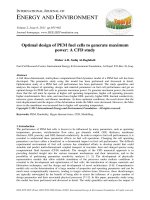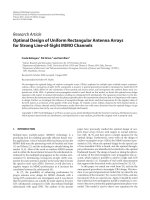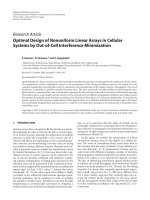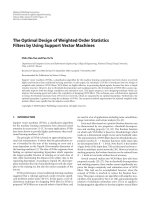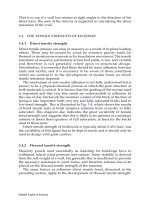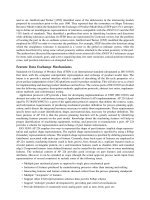Optimal design of photonic crystals 5 3
Bạn đang xem bản rút gọn của tài liệu. Xem và tải ngay bản đầy đủ của tài liệu tại đây (5.64 MB, 9 trang )
λ
h
CL,1
λ
h
WG,1
λ
h
WG,2
0.4
0.5
0.6
0.7
0.4
0.5
0.6
0.7
0.4
0.5
0.6
0.7
||H
2
(β
1
)||
2
−
||H
2
(β
1
)||
2
^
||H
2
(β
2
)||
2
−
||H
1
(β
1
)||
2
^
Figure 5.8: β
2
= 1.5. The figures in the columns from left to right each represent
the case: (left)initial configuration, with band width J
h
= 0.0122 (
ˆ
β
1
= 1.45);
(middle) optimal configuration when only cladding is optimized, with band width
0.048 (
ˆ
β
1
= 1.42); (right) optimal configuration when both cladding and core
are optimized, with band width J
h
= 0.15 (
ˆ
β
1
= 1.27). The first row illustrates
the PCF cross-sections. The second row shows the corresponding dispersion
relations between [
ˆ
β
1
, β
2
]. From the third row to the last, the magnetic field
intensities at both
ˆ
β
1
and β
2
are shown in 3D surf plots.
132
optimization formulations to design the single-polarization single-mode fibers.
Despite being governed by a different setup of the Maxwell’s equations, both the band
width and band gap optimization problems relates to maximizing the difference between two
consecutive eigenvalues over some parameter sets of wave vectors. As a result, the algorithm
based on approximate and reduced subspaces projection and SDP reformulation can be suitably
applied here with a few moderate variations.
The band width optimization problem was modeled by two formulations of three scenarios
each, and some resulting band structures together with validation of the field variable inten-
sity are presented. The results clearly demonstrated the success of our convex optimization
algorithm in these more complicated physical problems.
133
Chapter 6
Conclusions
We will conclude the thesis in this final chapter by first summarizing all the work and contribu-
tions to date; To put things in perspective, suggestions and proposals on further improvements
as well as extensions to a wider range of applications will be provided in the end.
6.1 Summary
The optimal design of photonic crystals has been the central theme of this work. The aim is
to develop convex optimization formulations that are reliable and efficient to design various
photonic crystal devices possessing important properties.
The notion of photonic crystals was introduced in chapter 1. These are a new class of
materials that are rapidly growing in popularity because of their unique features and superior
properties. Among these properties, the most important are the band gaps and the index guid-
ing. In the band gap phenomenon, a properly designed photonic crystal can exhibit a range
of prohibitive frequencies to the propagation of electromagnetic waves. In the index guiding
mechanism, the propagation of the electromagnetic waves of certain frequencies can be localized
in the core region of the photonic crystal device; while other frequencies are attenuated in the
waveguide according to the design requirements. The two features are similar in that their be-
havior can be almost completely predicted by examining the corresponding dispersion relations,
which provide us with the basic mathematical models for further analysis and optimization.
Having examined the previous work on the optimization of the band gaps, e.g., parameters
study or gradient-based optimization approach, we proposed to reformulate the nonlinear, non-
convex, large scale band gap optimization problem to tractable convex programs. We have also
identified another band width optimization problem based on index guiding in photonic crystal
fiber, to which we plan to extend the convex formulations
Chapter 2 is a collection of reviews on some fundamental physical and mathematical con-
cepts that are frequently used throughout this work. The central theoretical framework for
our modeling is based on the Maxwell’s equations – the governing equations for electromag-
134
netic waves propagating in dielectric material, as well as the symmetry theories and the Bloch
theorem that are used to simplify and recast the Maxwell’s equations to Hermitian eigenvalue
problems. Next, functional analysis and the finite element method as the numerical techniques
to solve the Maxwell’s equations were also summarized. Basic concepts on optimization, such
as, convex cone, generalized inequalities, and standard convex programs, for example, semidef-
inite program and second-order cone program, were reviewed as well.
As a first step to the optimal design, we strived to solve for the eigenvalues accurately
and efficiently in both physical problems in Chapter 3. The band gap problem for the two-
dimensional photonic crystal can fortunately be simplified to a scalar eigenvalue equation for
either transverse magnetic or transverse electric polarization of the EM waves. Standard fi-
nite element method with linear nodal basis functions can be applied, together with carefully
discretized wave vector and dielectric function spaces, to compute the eigenmodes with conver-
gence rate up to twice the order of the interpolation basis functions used.
We also introduced a simple adaptive mesh refinement procedure. The strategy is to
increase the discretization resolution to allocate more degrees of freedom, hence more com-
putational nodes, in regions where the eigenfunctions have higher gradient, and to maintain
a coarser discretization in regions of smooth solutions. Typically, the increased variation in
the eigenfunctions can be expected along the interfaces of the dielectric materials. An adaptive
computation mesh was obtained by successively refining the elements on the material interfaces
to the desired resolution, while maintaining the conformability of the finite element method.
Solving the Hermitian eigenvalue equations on the adaptive meshes, satisfactory numerical so-
lutions of the eigenmodes, and a convergence rate of as high as 9 has been observed in the few
examples analyzed.
The governing Maxwell eigenvalue equations for the photonic crystal fiber problem dis-
played some increased complexity. One complication is that they lead to a system of equations
involving both the transverse and longitudinal components of the field variables. Moreover, the
notorious spurious modes required special treatment of the transverse components of the field
variables, i.e., H(curl, Ω) conforming bases had to be used in the finite element approximation.
This was done in addition to the H
1
(Ω) basis functions applied for the longitudinal component
approximation. We formed the so called “mixed formulation”. When the lowest order of the
H(curl, Ω) interpolation basis functions are used in addition to the linear H
1
(Ω) basis functions
in the mixed formulation, the computed eigenmodes on successively finer computation meshes
are converging at a rate of 2 as well. Fortunately, the additional use of H(curl, Ω) conforming
basis functions did not require any special treatment to the mesh adaptivity procedure. The
convergence rate of the eigenvalues computed on the adaptive meshes was as high as 6.
The formal optimization formulation for the band gap problem was developed in chap-
ter 4. We started with a well-posed, but nonlinear, non-convex, and large-scale optimiza-
tion statement, with low regularity and a non-differentiable objective. Through restriction to
the appropriate eigenspaces, we reduced the large-scale non-convex optimization problem via
135
reparametrization to a sequence of small-scale convex semidefinite programs for which mod-
ern optimization solvers can be efficiently applied. Adaptive mesh refinement was naturally
incorporated to the optimization procedure. By initializing the optimizations with previously
optimized structure on coarser meshes, we obtained the final well represented optimal struc-
tures on adaptively refined meshes with improved computation cost. Numerical results and
extensive optimal designs of the two-dimensional photonic crystals are presented with optimal
band gaps of various configurations, e.g., absolute band gaps, complete band gaps, and multiple
band gaps. Among all the results, we have obtained various photonic crystal structure with:
single absolute band gap of gap-midgap ratio as high as 97.8%, as many as 4 multiple absolute
band gaps, and up to two complete band gaps in both square and hexagonal lattices.
In chapter 5, we studied the band width optimization problem arising in the photonic crys-
tal fibers due to index guiding mechanism. By proposing several formal convex optimization
formulations for the design of the single-mode single polarization fibers, we demonstrated that
the optimization recipes developed for the band gap optimization problem in chapter 4 could
be extended to solve this similar yet more complicated optimization problem. We also pre-
sented several optimal designs as a proof of principle, and verified the results by the intensity
plots of the localized and attenuated fields corresponding to the guided and unguided modes
respectively.
6.2 Future Work
While this thesis covers in great detail particular cases of the optimal design of photonic crystals,
the following directions are of great interest for the further development of this field.
Band gap optimization of three-dimensional photonic crystals
One of the most challenging problems in this field is the design of realistic photonic crystals,
i.e., structures with full three-dimensional periodicity. A 3D photonic crystal provides perfect
dielectric confinement of light of any polarization in all three dimensions by exhibiting a com-
plete band gap in its energy spectrum. However, a complete 3D band gap is very rare, as it
must smother the entire three-dimensional Brillouin zone. An increased dielectric constant is
very often not enough for all the directional gaps to be wide enough to create an overlap. Hence,
some lattice structures with nearly spherical Brillouin zone are preferred to construct the 3D
photonic crystal, e.g., face-centered cubic and diamond lattices. A number of 3D crystals have
been discovered to yield sizable complete photonic crystal band gaps [61, 31, 29].
Besides the physical feasibility, numerical complications should be taken into account in
the design of the photonic crystals. To solve the three-dimensional Maxwell’s equations, not
only will the degrees of freedom of the system increase, but also the number of decision vari-
ables. Moreover, a full vectorial, three-dimensional Maxwell’s equations also require the full
H(curl, Ω) conforming basis functions. Despite the 3D designs based on physical intuition
136
mentioned above, we have not come across any references on formal mathematical optimiza-
tion formulations. With the installment of subspace reduction and mesh adaptivity, we are
optimistic about the potential of our convex optimization algorithm in handling the 3D opti-
mization problem.
Phononic/photonic crystals
By analogy to the propagation of the electromagnetic waves in periodic dielectric material, the
propagation of the elastic waves in materials with periodic mechanical properties has estab-
lished another interesting field, phononic crystals. Extension of the band gap phenomenon and
optimization of the crystal structures of elastic materials have attracted considerable attention
[58, 52, 34, 41]. Another interesting design problem is the coupling of the two types of mate-
rials, and the construction of structures possessing both the photonic and phononic material
properties[40]. Based on the successful story of our algorithm, the optimal design of this type
of crystal is certainly a new and promising area of research.
Field localization
In all our optimization formulations, eigenvalues have been the solo actors of the objective func-
tions. They have been the natural and reasonable choices because the properties of eigenvalues
dictate many fundamental behaviors of the system, e.g., the propagation of the field variables.
In addition, the manipulation of eigenvalues can be easily redirected to the properties of the
matrices in the corresponding discrete eigenvalue equations, which can be further handled by
semidefinite cones and the associated generalized inequalities. Nevertheless, all these seem like
an indirect and winding detour to achieve convex optimization. One should be able to operate
more directly on the vector spaces. For example, the localization of the field variable can be
easily formulated as a least square problem [23] which is a subset of convex optimization; More
adventurously, one might even formulate it with first-order methods.
Uncertainties and robustness
Another area of focus involves the more practical issue of manufacturablility. During the stage
of fabrication, uncertainties or defects are prone to be introduced. Moreover, we note that many
of the optimized crystal designs shown in chapter 4 involve intricate patterns of materials at
the nano-level, and may be too expensive or even impossible to fabricate. Simply incorporating
fabrication constraints such as bounds on the curvature of boundaries or connectedness of
materials easily yields combinatorially intractable optimization models. Instead, we propose
to modify the basic optimization problem, so that a resulting solution is robust for fabrication
to account for both the uncertainties in the optimization formulation a priori, and to obtain
optimal structures that retain the desirable properties amidst the manufacturing defects. This
is somewhat in the spirit of robust convex optimization [8], and is the subject of future research.
137
Bibliography
[1] F. Alizadeh. Interior point methods in semidefinite programming with applications to
combinatorial optimization. SIAM Journal on Optimization, 5(1):13–51, 1995.
[2] F. Alizadeh and D. Goldfarb. Second-order cone programming. Mathematical program-
ming, 95(1):3–51, 2003.
[3] F. Alizadeh, J. P. A. Haeberly, and M. L. Overton. Primal-dual interior-point methods
for semidefinite programming: convergence rates, stability and numerical results. SIAM
Journal on Optimization, 8(3):746–768, 1998.
[4] L. An, Z. Zheng, Z. Li, Y. Liu, T. Zhou, and J. Cheng. Ultra-wideband single-polarization
single-mode photonic crystal fiber with high nonlinearity and low dispersion. In Asia
Communications and Photonics Conference and Exhibition. Optical Society of America,
2009.
[5] I. Babuˇska. The finite element method with Lagrangian multipliers. Numerische Mathe-
matik, 20(3):179–192, 1973.
[6] KJ Bathe. Finite element procedures. 1996. Prenctice Hall, 1996.
[7] K.J. Bathe and H. Zhang. A mesh adaptivity procedure for CFD and fluid-structure
interactions. Computers and Structures, 87(11-12):604–617, 2009.
[8] A. Ben-Tal and A. Nemirovski. Robust Convex Optimization. Mathematics of Operations
Research, 23:769–805, 1998.
[9] M.P. Bendsøe and O. Sigmund. Topology optimization: theory, methods, and applications.
Springer Verlag, 2003.
[10] JK Bennighof and L. Meirovitch. Eigenvalue convergence in the finite element method.
International Journal for Numerical Methods in Engineering, 23(11):2153–2165, 1986.
[11] TA Birks, JC Knight, P.S.J. Russell, et al. Endlessly single-mode photonic crystal fiber.
Optics letters, 22(13):961–963, 1997.
[12] F. Bloch.
¨
Uber die quantenmechanik der elektronen in kristallgittern. Zeitschrift f¨ur
Physik A Hadrons and Nuclei, 52(7):555–600, 1929.
[13] S.P. Boyd and L. Vandenberghe. Convex optimization. Cambridge University Press, 2004.
[14] F. Brezzi. On the existence, uniqueness and approximation of saddle-point problems
arising from lagrangian multipliers. RAIRO, Analyse numˇenique, 8(2):129–151, 1974.
[15] A. Buffa, P. Houston, and I. Perugia. Discontinuous Galerkin computation of the Maxwell
eigenvalues on simplicial meshes. Journal of Computational and Applied Mathematics,
204(2):317–333, 2007.
[16] M. Burger, S.J. Osher, and E. Yablonovitch. Inverse problem techniques for the design of
photonic crystals. IEICE Transactions on Electronics E Series C, 87:258–265, 2004.
[17] E. Cances, C. LeBris, N. C. Nguyen, Y. Maday, A. T. Patera, and G. S. H. Pau. Fea-
sibility and competitiveness of a reduced basis approach for rapid electronic structure
calculations in quantum chemistry. In Proceedings of the Workshop for High-dimensional
Partial Differential Equations in Science and Engineering (Montreal), volume 41, pages
15–57, 2007.
[18] A. Charnes and W. W. Cooper. Programming with linear functionals. Naval Research
Logistics Quarterly, 9, 1962.
[19] H. Ciria, J. Peraire, and J. Bonet. Mesh adaptive computation of upper and lower bounds
in limit analysis. International Journal for Numerical Methods in Engineering, 75:899–944,
2008.
138
[20] S. J. Cox and D. C. Dobson. Band structure optimization of two-dimensional photonic
crystals in H-polarization. Journal of Computational Physics, 158(2):214–224, 2000.
[21] B. D. Craven and B. Mond. The dual of a fractional linear program. Journal of Mathe-
matical Analysis and Applications, 42(3):507–512, 1973.
[22] B.M. Dillon and J.P. Webb. A comparison of formulations for the vector finite element
analysisof waveguides. IEEE Transactions on microwave theory and techniques, 42(2):308–
316, 1994.
[23] D.C. Dobson and F. Santosa. Optimal localization of eigenfunctions in an inhomogeneous
medium. SIAM Journal on Applied Mathematics, 64(3):762–774, 2004.
[24] M. Doosje, B. J. Hoenders, and J. Knoester. Photonic bandgap optimization in inverted
fcc photonic crystals. Journal of the Optical Society of America B, 17(4):600–606, 2000.
[25] S. Fan, J. D. Joannopoulos, J. N. Winn, A. Devenyi, J. C. Chen, and R. D. Meade.
Guided and defect modes in periodic dielectric waveguides. Journal of the Optical Society
of America B, 12(7):1267–1272, 1995.
[26] S. Fan, P. Villeneuve, J. Joannopoulos, and H. Haus. Channel drop filters in photonic
crystals. Optics Express, 3(1):4–11, 1998.
[27] G. Floquet. Sur les equations differentielles lineaires. Ann De L’ecole Normale Superieure,
2(12):47–89, 1883.
[28] J. D. Jackson. Classical Electrodynamics, 3rd ed. New York, Jhon Willey & Sons, 1999.
[29] J. D. Joannopoulos, S. G. Johnson, J. N. Winn, and R. D. Meade. Photonic crystals:
molding the flow of light. Princeton university press, 2008.
[30] S. John. Strong localization of photons in certain disordered dielectric superlattices. Phys-
ical Review Letters, 58(23):2486–2489, 1987.
[31] S.G. Johnson and JD Joannopoulos. Three-dimensionally periodic dielectric layered struc-
ture with omnidirectional photonic band gap. Applied Physics Letters, 77:3490, 2000.
[32] J. Ju, W. Jin, and M.S. Demokan. Design of single-polarization single-mode photonic
crystal fiber at 1.30 and 1.55 µm. Journal of lightwave technology, 24(2):825, 2006.
[33] C. Y. Kao, S. Osher, and E. Yablonovitch. Maximizing band gaps in two-dimensional
photonic crystals by using level set methods. Applied Physics B: Lasers and Optics,
81(2):235–244, 2005.
[34] A. Khelif, B. Aoubiza, S. Mohammadi, A. Adibi, and V. Laude. Complete band gaps in
two-dimensional phononic crystal slabs. Physical Review E, 74(4):46610, 2006.
[35] F. Kikuchi. Mixed and penalty formulations for finite element analysis of an eigenvalue
problem in electromagnetism. Computer Methods in Applied Mechanics and Engineering,
64(1-3):509–521, 1987.
[36] C. Kittel. Introduction to solid state physics. Wiley New York, 1996.
[37] J F. Lee, D K. Sun, and Z.J. Cendes. Full-wave analysis of dielectric waveguides using
tangential vector finite elements. Microwave Theory and Techniques, IEEE Transactions
on, 39(8):1262 –1271, Aug. 1991.
[38] K.K. Lee, Y. Avniel, and S.G. Johnson. Rigorous sufficient conditions for index-guided
modes in microstructured dielectric waveguides. Optics Express, 16(13):9261–9275, 2008.
[39] K.K.Y. Lee, Y. Avniel, and S.G. Johnson. Design strategies and rigorous conditions for
single-polarization single-mode waveguides. Optics Express, 16(19):15170–15184, 2008.
[40] M. Maldovan and EL Thomas. Simultaneous complete elastic and electromagnetic band
gaps in periodic structures. Applied Physics B: Lasers and Optics, 83(4):595–600, 2006.
[41] M. Maldovan and E.L. Thomas. Periodic Materials and Interference Lithography for Pho-
tonics, Phononics and Mechanics. Wiley-VCH, 2008.
[42] M.S.K.G. Martinez. Photonic bandgaps in two-dimensional semiconductor-dielectric com-
posite crystals. J. Opt. Soc. Am. B, 23:1460–1470, 2006.
[43] J. Mathews and R.L. Walker. Methods of Mathematical Physics. Addison-Wesley, 1970.
[44] H. Men, NC Nguyen, RM Freund, PA Parrilo, and J. Peraire. Bandgap optimization of
two-dimensional photonic crystals using semidefinite programming and subspace methods.
Journal of Computational Physics, 229:3706–3725, 2010.
[45] A. M´endez and TF Morse. Specialty optical fibers handbook. Academic Pr, 2007.
139
[46] Y. Nesterov and A. Nemirovskii. Interior-point polynomial algorithms in convex program-
ming. SIAM studies in applied mathematics, 13, 1994.
[47] G. S. H. Pau. Reduced-basis method for band structure calculations. Physical Review E,
Statistical, Nonlinear, and Soft Matter Physics, 76(4):046704, 2007.
[48] L. Rayleigh. On the maintenance of vibrations by forces of double frequency, and on the
propagation of waves through a medium endowed with a periodic structure. Philosophical
Magazine, 24(147):145–159, 1887.
[49] K. Saitoh and M. Koshiba. Single-polarization single-mode photonic crystal fibers. IEEE
Photonics Technology Letters, 15(10):1384–1386, 2003.
[50] O. Sigmund and K. Hougaard. Geometric properties of optimal photonic crystals. Physical
Review Letters, 100(15):153904, 2008.
[51] O. Sigmund and J. S. Jensen. Systematic design of phononic band-gap materials and
structures by topology optimization. Philosophical Transactions: Mathematical, Physical
and Engineering Sciences, pages 1001–1019, 2003.
[52] O. Sigmund, S. Jensen, et al. Systematic design of phononic band–gap materials and
structures by topology optimization. Philosophical Transactions A, 361(1806):1001, 2003.
[53] M. Soljacic, S. G. Johnson, M. Ibanescu, Y. Fink, and J. D. Joannopoulos. Optimal
bistable switching in nonlinear photonic crystals. Physical Review E, 66:055601, 2002.
[54] D. Sun, J. Manges, X. Yuan, and Z. Cendes. Spurious modes in finite-element methods.
IEEE Antennas and Propagation Magazine, 37(5):12–24, 1995.
[55] A. Tabarraei and N. Sukumar. Adaptive computations on conforming quadtree meshes.
Finite Elements in Analysis & Design, 41(7-8):686–702, 2005.
[56] R. H. T¨ut¨unc¨u, K. C. Toh, and M. J. Todd. Solving semidefinite-quadratic-linear programs
using SDPT3. Mathematical Programming, 95(2):189–217, 2003.
[57] L. Vandenberghe and S. Boyd. Semidefinite programming. SIAM review, 38(1):49–95,
1996.
[58] JO Vasseur, PA Deymier, A. Khelif, P. Lambin, B. Djafari-Rouhani, A. Akjouj, L. Do-
brzynski, N. Fettouhi, and J. Zemmouri. Phononic crystal with low filling fraction and
absolute acoustic band gap in the audible frequency range: A theoretical and experimental
study. Physical Review E, 65(5):56608, 2002.
[59] H. Wolkowicz, R. Saigal, and L. Vandenberghe. Handbook of semidefinite programming:
theory, algorithms, and applications. Kluwer Academic Publishers, 2000.
[60] E. Yablonovitch. Inhibited spontaneous emission in solid-state physics and electronics.
Physical Review Letters, 58(20):2059–2062, 1987.
[61] E. Yablonovitch, T. J. Gmitter, and K. M. Leung. Photonic band structure: The face-
centered-cubic case employing nonspherical atoms. Phys. Rev. Lett., 67(17):2295–2298,
Oct 1991.
[62] X. L. Yang, L. Z. Cai, Y. R. Wang, C. S. Feng, G. Y. Dong, X. X. Shen, X. F. Meng,
and Y. Hu. Optimization of band gap of photonic crystals fabricated by holographic
lithography. EPL-Europhysics Letters, 81(1):14001–14001, 2008.
[63] M. F. Yanik and S. Fan. Stopping and storing light coherently. Physical Review A,
71(1):013803, Jan 2005.
[64] F. Zhang, M. Zhang, X. Liu, and P. Ye. Design of wideband single-polarization single-mode
photonic crystal fiber. Journal of Lightwave Technology, 25(5):1184–1189, 2007.
140
